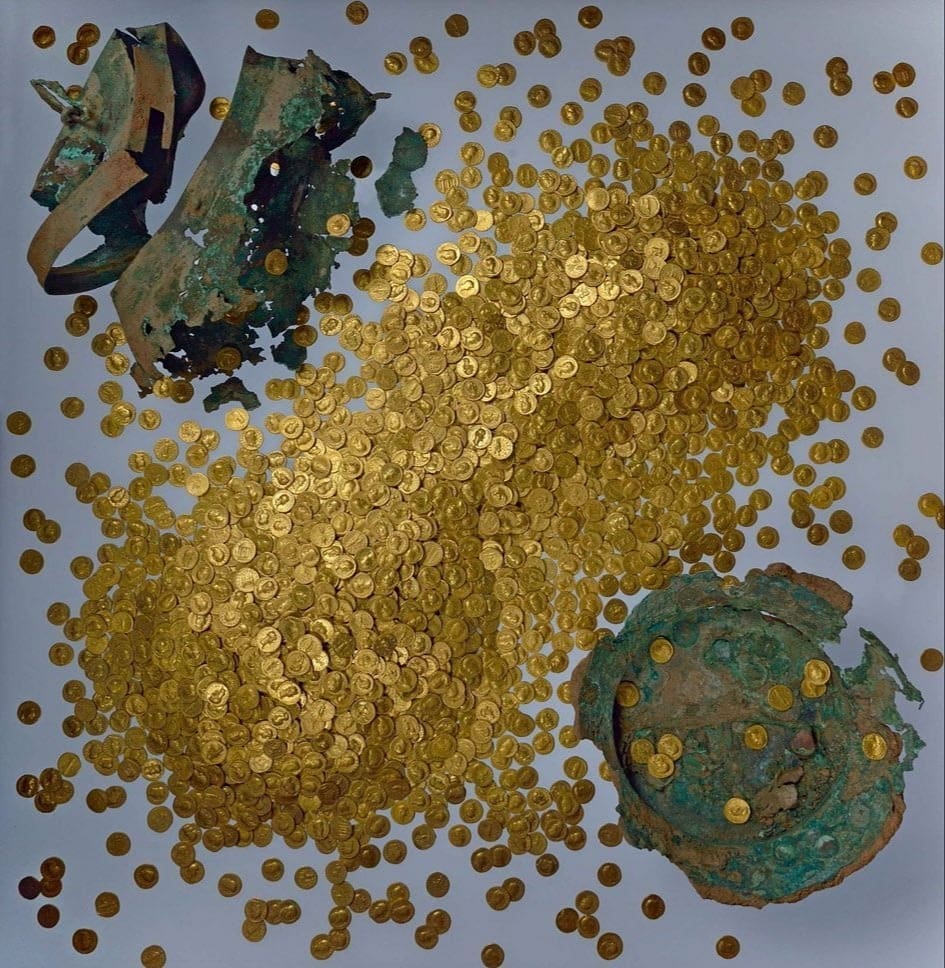The ‘Trier Gold Hoard,’ unearthed in 1993, stands as the largest Roman gold hoard ever discovered, a finding that continues to captivate archaeologists and historians alike. Comprising an extraordinary collection of 2,500 gold coins with a combined weight of 18.5 kilograms, this remarkable treasure was hidden nearly 1,800 years before its accidental discovery during excavation works in the German city of Trier. The sheer size and historical significance of the hoard made it a sensational find, offering profound insights into the Roman Empire’s economic and political history.

Upon detailed examination, experts determined that the hoard was not a simple accumulation of personal wealth. Rather, it was most likely an official treasury carefully managed and systematically expanded over time. The meticulous administration of the hoard suggests it served an institutional purpose, possibly for military or governmental use. To provide perspective on its immense value, the hoard’s worth equated to the annual salaries of approximately 130 Roman soldiers—a significant sum in the ancient world. The coins, known as aurei, featured detailed portraits of 27 different emperors, empresses, and imperial family members, each contributing to the hoard’s unique historical narrative. Some of these coins remain unparalleled, representing rare glimpses into the imagery and propaganda of the Roman imperial era.
The coins’ burial occurred during a tumultuous period in Roman history. In 196 AD, the empire was rocked by a civil war triggered by Clodius Albinus, who revolted against Emperor Septimius Severus. The conflict arose when Severus appointed his son, Caracalla, as his successor, bypassing Albinus. This political upheaval likely forced the administrator of the treasury to hide the gold in a cellar to safeguard it from the chaos and uncertainty of war. Tragically, the individual who concealed the hoard appears to have taken the secret of its location to the grave, leaving the treasure untouched for centuries.
The aurei coins themselves are a testament to the sophistication of Roman coinage. Each coin bears intricate designs, showcasing the skill of ancient engravers. These images served not only as currency but also as tools of imperial propaganda, reinforcing the authority and legitimacy of the ruling elite. The inclusion of portraits from multiple rulers and family members indicates the hoard’s extended accumulation over several reigns. This aspect makes the collection a rich resource for understanding shifts in imperial power and the evolution of Roman monetary systems.
Today, the Trier Gold Hoard is prominently displayed in the coin collection of the Rheinisches Landesmuseum Trier. As one of Germany’s largest archaeological museums, the museum provides an exceptional venue for showcasing this extraordinary find. Visitors can marvel at the coins, which are presented alongside detailed explanations of their historical and cultural significance. The exhibition not only highlights the coins themselves but also delves into the broader history of monetary systems, tracing the development of ancient, medieval, and modern currency production.
The museum’s coin collection room is a treasure trove of knowledge, housing a total of 12,000 coins from various historical periods. Through interactive displays and informational panels, visitors gain insights into the processes of coin minting and the economic systems that shaped societies across millennia. The presentation of the Trier Gold Hoard is complemented by extensive educational materials, making the exhibit an invaluable resource for both scholars and the general public.
One of the most fascinating aspects of the exhibition is the connection it draws between the hoard and the socio-political climate of its time. The civil war of 196 AD, during which the coins were buried, was a critical moment in Roman history. The struggle for power between Severus and Albinus reflects the volatility of the empire’s leadership and the lengths to which individuals would go to protect valuable resources. The hoard’s concealment is a poignant reminder of the uncertainty and danger that accompanied such conflicts.
Furthermore, the discovery of the hoard sheds light on the administrative practices of the Roman Empire. The systematic growth of the treasury suggests a high degree of organization and oversight, underscoring the empire’s ability to manage vast resources efficiently. This finding challenges modern perceptions of ancient economies, revealing a level of sophistication that rivals contemporary financial systems.
The Trier Gold Hoard also provides a window into the artistic achievements of the Roman Empire. The coins’ detailed engravings are remarkable for their precision and craftsmanship. Each portrait captures the individuality of its subject, offering visual representations of figures who played pivotal roles in shaping Roman history. These images serve as enduring symbols of the empire’s power and cultural influence.
In addition to its historical and artistic value, the hoard has sparked widespread public interest, drawing visitors from around the world to the Rheinisches Landesmuseum Trier. The museum’s efforts to make the collection accessible and engaging have played a significant role in fostering appreciation for this extraordinary find. By presenting the coins in their historical context, the exhibition allows visitors to connect with the past in a tangible and meaningful way.
The story of the Trier Gold Hoard—from its concealment during a period of political unrest to its rediscovery nearly two millennia later—is a testament to the enduring legacy of the Roman Empire. It highlights the complexities of ancient societies and the remarkable achievements of their people. The hoard’s preservation and display serve as a bridge between the past and the present, offering invaluable lessons about history, culture, and human ingenuity.
For those who wish to explore the Trier Gold Hoard, a visit to the Rheinisches Landesmuseum Trier is an unforgettable experience. The museum’s commitment to preserving and interpreting this treasure ensures that its significance will be appreciated for generations to come. Through its comprehensive exhibition, the museum invites visitors to embark on a journey through time, discovering the stories and secrets hidden within the largest Roman gold hoard ever found.





